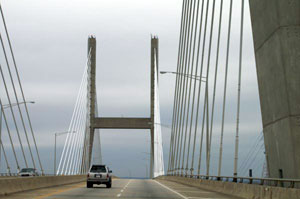 (August 2007) These days, a drive across a bridge is not always a pleasure cruise. Mindful of the war on terrorism, it can often be a cautious experience.
(August 2007) These days, a drive across a bridge is not always a pleasure cruise. Mindful of the war on terrorism, it can often be a cautious experience.
In one scenario, someone sets off a series of bombs to weaken the cables and the key structural connections of a major city bridge, all during rush hour. Not easy to do, but now thinkable. Earlier this month, the possibility of sabotage was quickly examined—then dismissed—when a bridge tragically collapsed in Minneapolis.
As authorities monitor and stand guard over bridges, the Science &Technology Directorate (S&T) is looking to scientists and engineers for the security technologies of tomorrow. What if, for instance, we could one day not only guard bridges but fortify them? Like Superman’s blue suit, what if the cables and connections on bridges could be shielded with protective sleeves or covers, making them nearly impossible for the villains to penetrate?
This is the goal of Department of Homeland's (DHS) bridge-strengthening research. Through a partnership with the U.S. Army Corps of Engineers’ Engineer Research and Development Center, the Directorate’s Infrastructure and Geophysical Division is testing current bridge designs and investigating advances in steel and reinforced concrete to explore whether such shields could work.
The first step is to determine which bridges and materials are most vulnerable, says Stanley Woodson, who oversees the project at the Center’s Geotech and Structures Lab. A major focus, he says, are the cables and the support columns—or towers—that are used in the cable-stayed design of bridges. Unlike the cables of a suspension bridge, which are attached from tower to tower, the cables in a cable-stayed bridge are connected directly to accessible points along the horizontal bridge deck.
In controlled experiments, Woodson’s team has been re-creating the forces holding up these bridges and blowing up samples of their cables, using various kinds of explosives. They then use sophisticated software to analyze the impact and results. “We tension the cables just like a real bridge,” he says. “We want to see just how they’d react in an actual terrorist event.”
The next step will be more complicated, says Woodson: Determining what material would suffice for another layer of protection, and what form it should take. “We’re looking at the practical as well as the innovative,” he says, recognizing the potential for high costs.
By the end of 2008, Woodson and his team will be imitating concrete bridge towers and subjecting them to the same explosive testing.
To request more information about this story, please e-mail st.snapshots@hq.dhs.gov.
